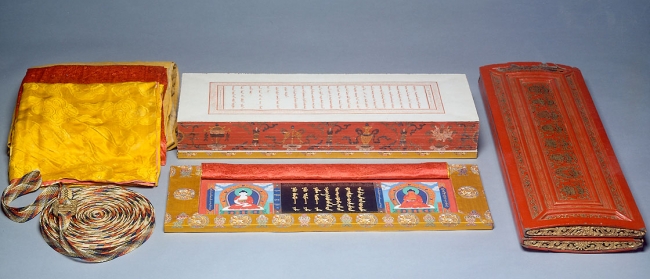TELDAP Collections
| Tripitaka in Tibetan / Tripitaka in Manchu |
|
With more than 2000 years of history, Buddhism has long been a major world religion. The translation of Buddhist scriptures, known as sutras, into Tibetan and Manchu not only preserved the language and history of these peoples in China but also assists in the study of Eastern culture. Sutras are therefore a crucial source of historical material. A compilation of Buddhist texts is called a tripitaka. A tripitaka in the Museum collection was written in Tibetan during the reigns of the K'ang-hsi and Ch'ien-lung emperors and composed of 122 sets. The vermilion court imprint in Manchu from the Ch’ien-lung reign contains 32 sets, making for a total of 154. The sutra boxes in each set include individual leaves, front and back boards, and wrappings. The tripitaka in Tibetan written in gold ink, known as the Kanjur Tripitaka, has leaves written on both sides in standard script. Each set contains 300 to 500 leaves. The sutra leaves, arranged in order, are decorated with the Eight Auspicious Symbols painted in gold ink. The boards include an inner and an outer pair. The outer pair is made of red lacquered wood and on front is an inscription in Sanskrit that reads, "Om-mani-pad-me-hum," an invocation against evil. The inner pair is made of dark bluish wood, and the reverse of the top piece is carved with gold characters in both Sanskrit and Tibetan for the Buddha, the Law, and the Order. The top piece is wrapped in layers of white, blue, green, red, and yellow silk, each embroidered with Sanskrit and Tibetan letters along with images of the Eight Auspicious Symbols. The lower piece is painted with five Buddhist images in color. The leaves between the two boards are then bound with silk thongs along with a white silk ceremonial hada cloth and finally wrapped in yellow sutra silk to form a set. This format of sutra mounting originated in India and was followed in Tibetan Buddhism, becoming known as "Indian board mounting". Anonymous, Ch'ing Dynasty (1644-1911)
|













